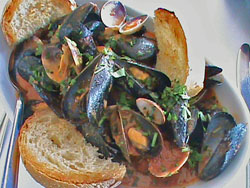As a Rhode Island native I was drawn into the usual saltwater pastimes like fishing, boating and swimming. After all Rhode Island is officially called the Ocean State, don’t you know, even though it has about 1/100th the ocean shoreline as Florida.
For me the most rewarding saltwater time killer was capturing sedentary and helpless bivalves on Narragansett Bay that had no way of escaping once I got hold of them with primitive tools such as a clam rake or oyster tongs. I got to be pretty good at it and I carried this dubious skill with me when I moved to Washington D.C. and eventually the Eastern Shore of Maryland on retirement. I have the rubber chest waders and clam rake up in the attic to testify as to the truth of all this. Notice I said “up in the attic.”
In the world of shellfish knowledge of the proper nomenclature is important if you are not motivated for clam digging and have to truck on down to the fish market to buy your shellfish. You need to know what to ask for.
There are dozens of varieties of hardshell clams but the most familiar goes by the redundant official name Mercinaria mercenaria. Within that category there are differences based on size. The largest hardshells have two names depending on whether you are a Rhode Islander or someone less fortunate. If a Rhode Islander you will be acquiring “quahogs,” the Algonquian Indian name given to fist-sized chowder clams. They are only good ground up for soups, stews, stuffing and fried clam cakes – the latter being an item sold exclusively in Rhode Island and nowhere else. A mystery because they are delicious and deserve national attention.
Next down the line we have top necks and cherrystones. Since clams have no necks I don’t know how this word crept into the description. In any case either one can be used for raw clams on the half-shell or baked Clams Casino.
 Lastly we get down to the small ones, i.e. the little necks and countnecks. These are the ones best for classic spaghetti alle vongole or spaghetti with clam sauce – a popular dish throughout Italy and the coastal U.S. as well. Supermarkets sometimes offer a variety of small brown colored clams from Asiatic waters called mahogany clams (maybe Phillipine mahogany??) a distant relative of the U.S. hardshell but good enough for all the spaghetti recipes.
Lastly we get down to the small ones, i.e. the little necks and countnecks. These are the ones best for classic spaghetti alle vongole or spaghetti with clam sauce – a popular dish throughout Italy and the coastal U.S. as well. Supermarkets sometimes offer a variety of small brown colored clams from Asiatic waters called mahogany clams (maybe Phillipine mahogany??) a distant relative of the U.S. hardshell but good enough for all the spaghetti recipes.
Drilling down even further, if you order spaghetti alle vongole in Genoa or Naples you will notice the hardshell clams in your dish are about the size of your thumbnail. Have to say that sauces made with these sweet “mini-necks” have no equal, but they are nowhere to be found in the U.S. as far as I can tell.
Incidentally people claim that here on the Eastern Shore of Maryland – a region known for its more or less southern conservative outlook on life – there exists another hard clam subspecies. They’re called Red Necks. Haven’t found any yet but I know they’re out there somewhere on the waters of Assawoman Bay. (Yes, Assawoman Bay – no joke – it’s an actual place name and it’s right outside my back door).
The other shellfish varieties relatively easy to catch on a hot summer day in the saltwater shallows are mussels and oysters. Here again we confront a nomenclature issue. It has to do with the oyster. Around the world the oyster is an oyster, but on the Maryland Eastern Shore it is an “orshter.” This is important because if you approach an Eastern Shore fishmonger and ask for oysters you will get a blank stare. They only sell orshters. Two dozen orshters please.
For now we are leaving oysters, scallops, soft-shell clams aside to zero in on clams and mussels.
 To do that let’s now switch over to a resort and fishing port suburb of Rome, Italy, called Fiumicino – known more for the big international airport nearby (code name FCO) than anything else. On a recent visit, instead of heading directly for Rome, I cabbed on over to the Fiumicino beach front and at the cabbie’s suggestion got dropped off at a restaurant called Il Veliero – The Sailing Ship. Here for lunch and in glorious weather I had the good fortune to select – entirely at random – their version of shellfish soup containing strictly clams and mussels in a light tomato broth.
To do that let’s now switch over to a resort and fishing port suburb of Rome, Italy, called Fiumicino – known more for the big international airport nearby (code name FCO) than anything else. On a recent visit, instead of heading directly for Rome, I cabbed on over to the Fiumicino beach front and at the cabbie’s suggestion got dropped off at a restaurant called Il Veliero – The Sailing Ship. Here for lunch and in glorious weather I had the good fortune to select – entirely at random – their version of shellfish soup containing strictly clams and mussels in a light tomato broth.
The uninspiring name for it on the menu is “Soup with Clams and Mussels”. No shrimp, calamari, crab or anything. It was served up with crusty bread slices. The dish exceeded all expectations. When it was time to go I confronted the chef on the way out and under duress he agreed to reveal the recipe after promising him I would keep it a secret at all cost. It is as follows:
Zuppa di Cozze e Vongole “Il Veliero”
For 4 persons:
-
2 doz. top neck or 2 1/2 doz. littleneck clams scrubbed clean
-
2 dozen or so mussels scrubbed clean and beards removed if any
-
1 28 oz. can tomato sauce or puree
-
1/2 cup chopped fresh flat leaf parsley
-
1 tbsp. chopped fresh dill weed
-
2 large cloves garlic (more if you’re a garlic lover)
-
2 cups dry white wine
-
2 cups fish or vegetable bouillon (try to resist the temptation to use chicken)
-
1 tbsp. fresh lemon juice
-
1/2 teaspoon crushed fennel seeds
-
2 tbsp. fresh celery leaves finely chopped
-
1/4 cup or so extra virgin olive oil
-
salt & freshly ground black pepper to taste
-
Toasted French bread slices
 In a large soup pot or dutch oven soften garlic in hot olive oil. Do not brown the garlic! Remove it from the pan, chop finely and set aside. Place the clams in the pot on medium high heat. Add wine, lemon juice, parsley and dill. When clams just start to open add the mussels. Stir and continue cooking until all shellfish is fully opened up. With tongs remove everything from the pot and set aside. Let the wine broth reduce slightly then add the boullion and tomato puree to the pot along with fennel seeds, celery, lemon juice and reserved garlic. Heat thoroughly then return all shellfish to the pot and continue cooking on medium heat for about 5 minutes. Serve with the toasted french bread although the customary alternative choice for the starch accompaniment in this recipe would be linguine. Try both.
In a large soup pot or dutch oven soften garlic in hot olive oil. Do not brown the garlic! Remove it from the pan, chop finely and set aside. Place the clams in the pot on medium high heat. Add wine, lemon juice, parsley and dill. When clams just start to open add the mussels. Stir and continue cooking until all shellfish is fully opened up. With tongs remove everything from the pot and set aside. Let the wine broth reduce slightly then add the boullion and tomato puree to the pot along with fennel seeds, celery, lemon juice and reserved garlic. Heat thoroughly then return all shellfish to the pot and continue cooking on medium heat for about 5 minutes. Serve with the toasted french bread although the customary alternative choice for the starch accompaniment in this recipe would be linguine. Try both.
Finally, just to get you properly oriented geographically here’s a partially obstructed shot of the Tyrrhenian Sea near Rome taken from the restaurant’s oceanfront terrace:

